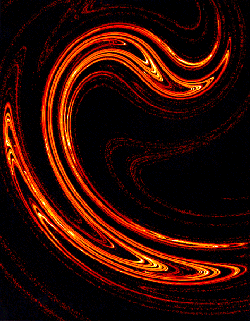Anticipating Chaos: Just Smoke and Mirrors?

Chaos, like next year’s weather, is anything but predictable. So results appearing in the 8 October print issue of PRL may seem paradoxical: researchers claim that for the first time, two lasers have been synchronized so that one can anticipate the chaotic fluctuations in the other. Some experts are skeptical of the result, but it illustrates some of the challenges in the field of chaos research, where physicists are attempting to understand and make use of nature’s seeming disorder.
The weather is a classic example of chaos. In a perfect world, a computer–given a complete set of atmospheric data and equations–should be able to crunch out forecasts for years to come. But in practice, tiny uncertainties in the initial data set eventually lead to completely inaccurate predictions. A laser also becomes very unpredictable if you reflect a small portion of the laser’s output back into the device. This feedback makes the laser’s future output–like next year’s weather–strongly dependent on its past.
Alan Shore and his colleagues at the University of Wales in Bangor, UK, created fluctuations in their first laser–the “transmitter”–using this standard feedback technique. They also fed some of the transmitter’s light into a second, “receiver” laser, which went into fits of intensity fluctuations nearly identical with those of the transmitter. The team arranged the mirrors in a way that gave the transmitter’s feedback signal a long round trip, so the receiver got the signal earlier and anticipated the transmitter’s fluctuations by a fixed amount of time.
Surprisingly, that fixed anticipation time did not depend upon the round-trip time for light to re-enter the transmitter. Several researchers have pointed out that even the tiniest amount of accidental light traveling from the receiver back to the transmitter could induce unintended fluctuations in the transmitter. They suggest that the receiver might not be anticipating fluctuations in the transmitter, but rather, causing them. Shore says that there is a small amount of feedback from the receiver to the transmitter, but that his team has shown that this feedback is not causing the fluctuations in the transmitter–a result they will soon publish.
Although many experts want to consider this result more carefully, they are optimistic about the potential usefulness of chaos synchronization. Dan Gauthier of Duke University in Durham, NC, suggests one possible application for anticipating chaos: researchers could maintain an extremely steady laser intensity by using the advanced signal to counter fluctuations quickly. Ingo Fischer, of the University of Darmstadt in Germany, still sees open questions in the interpretation of the new results, but is fascinated by the synchronization of chaotic lasers. He says researchers are still dreaming up applications. Unfortunately, one critical phenomenon seems to be missing from his list: predicting the weather.
–Rebecca Slayton
Rebecca Slayton is a freelance science writer in Cambridge, MA.


